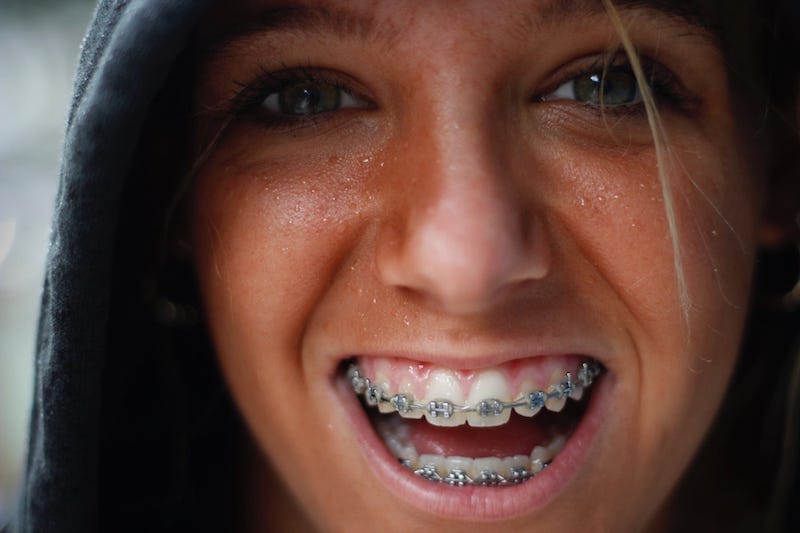WHAT IS ORTHODONTICS?
It is the specialty whose objective is to balance and achieve harmony in the masticatory system, both in children and adults, so it is never too late to start this treatment. It is a set of movements of the teeth to improve their function, aesthetics and bite.
With orthodontics treatment the ideal position is sought between all teeth in relation to the jaws and the joint that joins them with the base of the skull. In addition, it ensures a good bite function taking into account the anatomical differences of each patient.
It is important to bear in mind that an orthodontic treatment is much more than an aesthetic solution, more than a simple alignment of the teeth. The healthy life of the teeth, gums and jaw joint is achieved, thus providing the well-being of your mouth.
The first step is to do an orthodontic study to obtain the diagnosis and plan the necessary treatment.
HOW DO I KNOW IF I NEED ORTHODONTIC TREATMENT?
The need for treatment is different for each person. Each case is very individual and personalized, no two cases are the same. The purpose is to bring the teeth into their ideal position so that they bite properly. By balancing the contacts, they tend to last healthy for many years.
MAIN REASONS FOR ORTHODONTIC TREATMENT:
Increase or keep space:
When baby teeth are changed, there may be a lack of space for permanent teeth. Orthodontic appliances are used to maintain or create the space necessary for permanent teeth to grow in place.
Crowding:
To align crooked, crowded teeth, improving the appearance of your smile and avoiding problems caused by poor dental hygiene. Properly aligned teeth work better, clean better, and don't wear out unnecessarily. Dental caries development is caused by poor dental hygiene. Between the crowded teeth there is a perfect space for bacteria and plaque difficult to remove with daily hygiene, the main cause of cavities and tooth loss.
A good bite needs its ideal position:
The bite in a bad position causes the the teeth to wear out and their subsequent loosening. The deterioration of the jaw bones and joints develops with consequences such as migraines, noise in the ears, pain in the neck, vertigo, etc.
THE MOST COMMON BITE PROBLEMS ARE:
Cross bite:
One or more upper teeth close behind or outside the lower teeth.
Openbite:
When there is a space between the upper and lower anterior teeth because they do not close between them, but between the back teeth.
Overbite or augmented bite:
The upper teeth completely cover the lower teeth when the bite is closed.
The deviated midline:
The center between the upper teeth does not coincide with the center or midline of the lower teeth.
Gum retraction:
Due to the poor positioning of the teeth, they receive excessive and harmful force, causing the gums to retract and ultimately loosen. Teeth wear out faster and their life is dramatically shorter. Many people lose their teeth from overuse.
Temporomandibular joint (TMJ) problems:
It is the joint that joins the two jaws with the base of the skull. When our teeth are in a bad position, they bite badly and this causes the degenerative processes of the TMJ. The muscles work forcibly to try to stabilize the joint causing muscle, neck and ear pain, and also migraines.
TYPES OF ORTHODONTICS:
Interceptive orthodontics, in children:
It is orthodontics that, as its name suggests, intercepts the problem before it occurs. It is performed with fixed and removable appliances that help maintain the space between the teeth by acting on the bones that support the teeth. The appliances gradually expand the jaws bringing them to the desired position, preventing crowding and other future permanent tooth problems.
Corrective orthodontics:
For both young people and adults, it serves to correct problems of functionality and aesthetics. The choice of the orthodontic system is made together with the professional depending on each case.
THE MOST USED SYSTEMS ARE:
Fixed orthodontics with braces:
The braces are placed on the outer face of the teeth.
There is also another more aesthetic form of braces that is placed on the inside of the teeth. Both systems work in the same way, by changing the thickness of the wire, the necessary force is achieved to bring the teeth to the desired site.
Braces placed on the outer face are one of the techniques most chosen for their simplicity, speed and good value for money.
Orthodontics with invisible dental aligners:
It is a treatment with dental transparent splints or aligners, made of plastic, as they are changed, they alter the position of the teeth, placing them in the desired position. The orthodontic aligners are changed every 7-15 days for a new set so that the teeth move into their optimal position. They are completely personalized, imperceptible and very comfortable.
Both the number of sets required and the duration of treatment will depend on the complexity of the case. The duration of treatment is also proportional to the complexity.
WHAT WILL BE THE DURATION OF MY ORTHODONTIC TREATMENT?
Each case is different and may vary, but as a general rule we can estimate that the case will usually be resolved in between one and two years.
The last phase is very important and is done with dental retainers.
Once the orthodontic treatment is finished, dental retainers are manufactured so that the teeth do not return to their previous position. If this phase is overlooked, the teeth may eventually move and return to their previous position. To prevent this from happening, upper and lower transparent dental splints are delivered (to wear at night) or if your case requires, a fixed dental retainer.
Thus the result obtained with the orthodontic treatment will be maintained forever.

